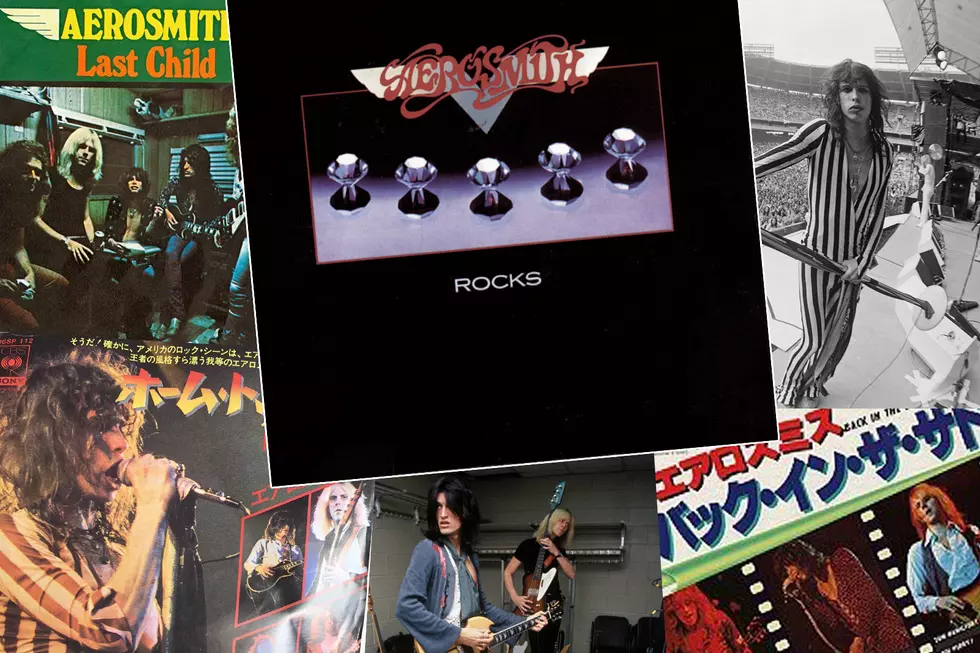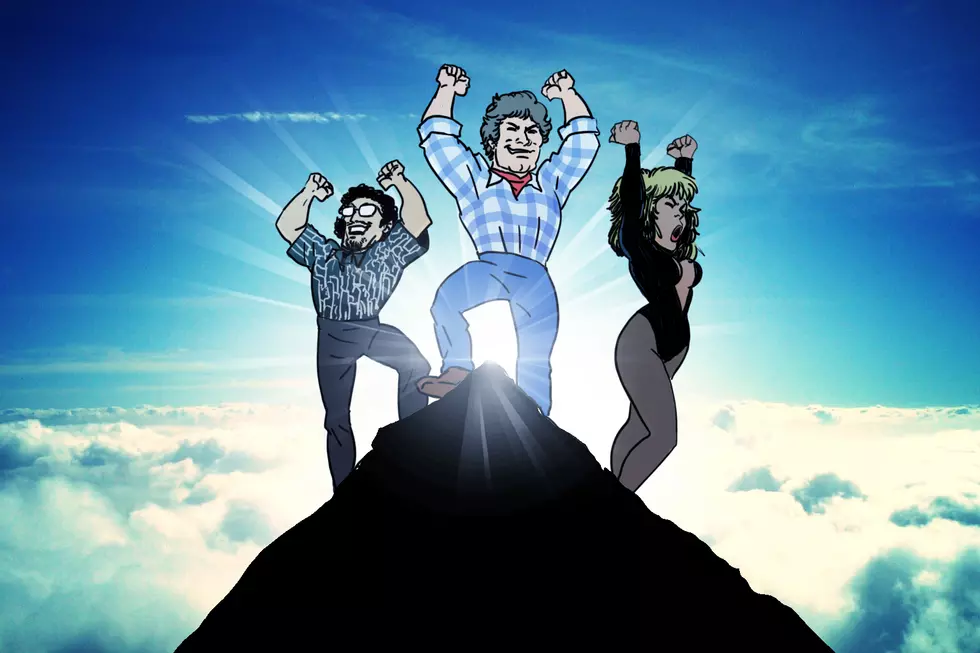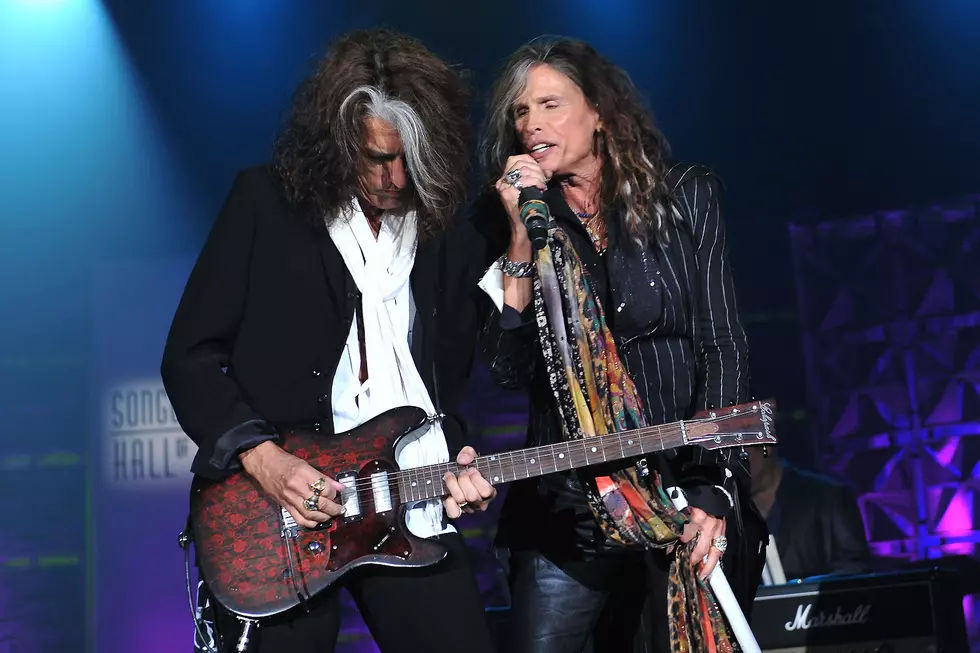
Aerosmith’s ‘Rocks': A Track-by-Track Guide
Aerosmith finally broke through with 1975's Toys in the Attic, but their collective creativity was still peaking. So they went right back into their private studio, the Wherehouse just outside of Boston, to rehearse fresh material before moving the proceedings to the Record Plant in New York City.
There was a lot to live up to, beyond the success of Toys in the Attic. January saw Columbia Records re-release “Dream On,” and the three-year-old single finally caught on as a rightful anthem on U.S. rock radio right alongside Lynyrd Skynyrd’s “Free Bird” and Led Zeppelin's "Stairway to Heaven." It was the first Aerosmith track to reach the Top 10, making it to No. 6 in April. Rocks arrived in stores following that milestone on May 14, 1976, peaking the following month at No. 3 on the charts.
Guitarist Joe Perry had wanted to call their previous album Rocks, but the title suited this nine-song follow up much better. It’s a thick and ballsy statement LP that most acts can only dream of putting together.
“Diamonds are called rocks, and nothing is harder than a diamond,” Perry said in his book named after the record, Rocks: My Life In and Out of Aerosmith. “I wanted the hardest-rocking record imaginable.”
Producer Jack Douglas was back onboard, and he came up with the idea to bring the Record Plant’s mobile recording truck to Massachusetts and back it into the Wherehouse. This way Aerosmith could use the comfortability and warm sound of their home turf to begin building out a fuller record more representative of their truest musicianship.
Perry and Steven Tyler were writing songs at the singer’s new house in Lake Sunapee, N.H., while the rest of the group started pre-production with Douglas. Rocks would see guitarist Brad Whitford and bassist Tom Hamilton taking on a greater role in the songwriting process, with Douglas encouraging them along the way.
“This was a big album for Aerosmith,” Douglas said in Walk This Way: The Aerosmith Autobiography. “It had to make a big statement about how loud and hard they were, how unapologetic they felt about being who they were – this brash, rude, sexual hardcore rock band.”
The result was one of Aerosmith's very best records, and a moment of inspiration for a slew of musicians – notably Slash from Guns N’ Roses and James Hetfield of Metallica. Here’s a track-by-track breakdown of how they got there:
“Back in the Saddle”
Inspired by country crooner Gene Autry’s “Back in the Saddle Again,” Douglas wanted Tyler to use the image as a metaphor for the band's quick return.
“Steven went into the stairwell for two hours," Douglas said in Walk This Way, "and came back with reams of paper with ideas on them, and we cut the vocals.”
Douglas placed a shotgun microphone 10 inches away from Tyler's mouth to capture his notorious screams. The singer then started playing with the effects on the device, and moved his head so he’d be singing under or above it at different points, resulting in a raspy and in-your-face delivery.
Tyler also handled the sound effects, stomping his cowboy boots on a large piece of plywood for a tough, rootsy effect. He created the sound of spurs by gaffer taping tambourines and bells to each, with help from David Johansen after the New York Dolls singer stopped by the studio. Tyler used two coconut halves to mimic galloping horses, heard toward the end of the track.
There were multiple, ill-fated and injury-plagued takes, however, as Tyler tried to add a bullwhip. He eventually settled on using a 30-foot microphone cord in its place, with a cap gun to get the cracking sound.
Perry came up with the riff on a six-string bass while doing heroin in his bedroom, as “Back in the Saddle” became one of a handful of Rocks tracks born out of his and Tyler’s usage of the drug.
“The music flew out of me – all the parts, all the riffs. It came in one special delivery package,” Perry said in his autobiography. “I was still in the stage when the drugs were opening doors to my imagination. And I was lucky enough to have a connection that got me heroin as close to pure as I would ever see.”
This was also the first of five songs where Whitford played lead guitar, hinting at the larger role he’d take on Rocks. "Back in the Saddle" later became the album's final single, just cracking the Top 40 in early 1977.
“Last Child”
Whitford came up with the riff for “Last Child,” earning a co-writing credit while developing it further with Tyler at the drums. Perry then came up with some chord changes, and Douglas invited guest picker Paul Prestopino into the sessions when the band decamped to New York City to finish the record.
“There’s a slide guitar part on ‘Last Child’ that I had Paul double with what we called a ‘slide banjo,’” Douglas said. “There’s not supposed to be such a thing, but this metallic sound gave the song a subtle, organic feel that sounded great on a rock ‘n’ roll record. Steven just loved that kind of stuff.”
“Last Child” reached No. 21 when it was released as the first single from Rocks.
“Rats in the Cellar”
“I wrote ‘Rats in the Cellar’ as a tip of the hat, or an answer to ‘Toys in the Attic,’” Tyler said in his memoir Does the Noise in My Head Bother You? “Rat/cellar – toys/attic. Meanwhile, in real life, ‘Rats’ was more like what was actually going on. Things were coming apart, sanity was scurrying south, caution was flung to the winds, and little by little chaos was permanently moving in.”
Originally titled “Tit for Tat,” the song was heavily inspired by Fleetwood Mac's “Searching for Madge.” Perry's chugging, bluesy, classic solo aligned perfectly with Tyler’s lyrics.
“Both he and I were intent on getting into the grit and grime of the basement,” Perry said in Rocks: My Life In and Out of Aerosmith. “The band was getting lower, downer and dirtier, so the cellar seemed like the best place to go. That’s where we found the rats.”
According to Hamilton, “Rats in the Cellar” epitomized where the band was musically at the time. "The end of ‘Rats’ is this fuckin’ thing that builds and builds,” he said in Walk This Way. “It’s us doing the Yardbirds' trip – because we were so blown away by the idea of taking this music and making it balls to the wall.”
“Combination”
Perry arrived with a stockpile of riffs for songs – but that’s all they were. So out of pure boredom, he started writing lyrics. The result was Perry's first shared lead vocal, as “Combination” in many ways became his signature track as a singer.
“This was a touchy subject because singing was Steven’s jealously guarded territory,” Perry said in Rocks: My Life In and Out of Aerosmith. “Being in a band with one of the best singers in the world set up an inevitable comparison. In that comparison, I ain’t gonna look too good. But what the fuck? I couldn’t let that stop me. As the great blues prophet John Lee Hooker once said, ‘If it’s in him, it’s gotta come out.’
"Beyond that, anytime the spotlight shone on me, I detected a bit of jealousy from the other guys," Perry added. "After a while, though, the band came around and supported me, as long as I sang the song as a semi-duet with Steven.”
“Sick as a Dog”
One of the earliest songs put together for the album, "Sick as a Dog" grew out of a rough Hamilton idea initially dubbed “Uncle Tom’s Cabin.” What made the track unique is that the bass player switched to guitar, while Perry was on bass.
When the band recorded "Sick as a Dog" at the Record Plant, Perry would take off the bass and hand it to Tyler, then pick up a guitar to do his solo. “Looking like the Keystone Cops, we did this three or four times before we figured out who was going to run where and through what door,” Perry said in his autobiography. “It took a while, but we ended up with a great live take.”
“Nobody’s Fault”
“Nobody’s Fault” is, along with “Round and Round” from Toys in the Attic, one of the darkest and hardest compositions in the Aerosmith catalog. In fact, it's so heavy that the thrash band Testament saw fit to cover it on their second record, 1988’s The New Order.
As with “Round and Round,” “Nobody’s Fault” was co-written by Whitford, who also handled both lead and rhythm guitar. “I had this one lick that lasted about a minute,” Whitford said in Walk This Way. “We recorded it and Jack wrote ‘Soul Saver’ on the box. We kept changing it until we had a different sounding take on this cool lick.”
Tyler’s lyrics echo the bleakness of the music, with an earthquake theme inspired by the natural disaster in Nicaragua that left thousands dead in 1972. A subsequent temblor in southern California, then learning about the fault line that ran underneath a New Jersey nuclear-power plant, ended up sparking a deep-seated band-wide fear – but also an inspirational performance.
Tyler calls this track “one of the highlights of my creative career” in Does the Noise in My Head Bother You?, while Joey Kramer said "Nobody's Fault" features some of the best drumming he’s ever done.
“Get the Lead Out”
Oozing sex and sleaze, "Get the Lead Out" is a showcase for Perry, who called the song a "straight-up exhortation to get up and dance" in Rocks: My Life In and Out of Aerosmith.
Tyler wanted to get an opera singer to double his voice for a portion of the track where he sings, “No no/No no/No no." Douglas recruited an unknown from the Metropolitan Opera to come to the studio.
“But he couldn’t anticipate the note because in opera there’s nothing before the downbeat,” Douglas said in Walk This Way: The Autobiography of Aerosmith. “We worked with him all night, blew his voice out, and in the end, I had to move the vocal up by playing it off the synch-head instead of the playback head. I think we traumatized the poor guy.”
“Lick and a Promise”
Led by Kramer’s fade-in drum intro, “Lick and a Promise” is about playing for and winning over an audience according to Tyler. “Such a snapshot of us in those days, a clear moment in time for me,” he said in Does the Noise in My Head Bother You?
The song was meant to sound like Aerosmith were playing live, and there’s a part in the final third where listeners can hear a crowd calling for more. In reality, there were just six people in the studio – including drug dealers and assistants.
Douglas recorded them and doubled it, then repeated that and boosted it until the recording came to resemble an arena full of fans.
“Home Tonight”
Stylistically like nothing else on Rocks, “Home Tonight” repeated the Toys in the Attic formula of closing things out with a ballad, much as that LP did with “You See Me Crying.”
Aerosmith had high hopes for the track, which grew out of a turn by Tyler at the piano. They released it as this project's second single, hoping “Home Tonight” would follow in the hitmaking footsteps of “Dream On.” Instead, the track didn’t make much of an impact, stalling at No. 71 on the charts.
Tyler later underscored the connection by occasionally performing a snippet of "Home Tonight" as an in-concert intro to "Dream On."
See Aerosmith Among the Top 200 '70s Rock Songs
Why Don't More People Love This Aerosmith Album?
More From 98.7 The Bomb










